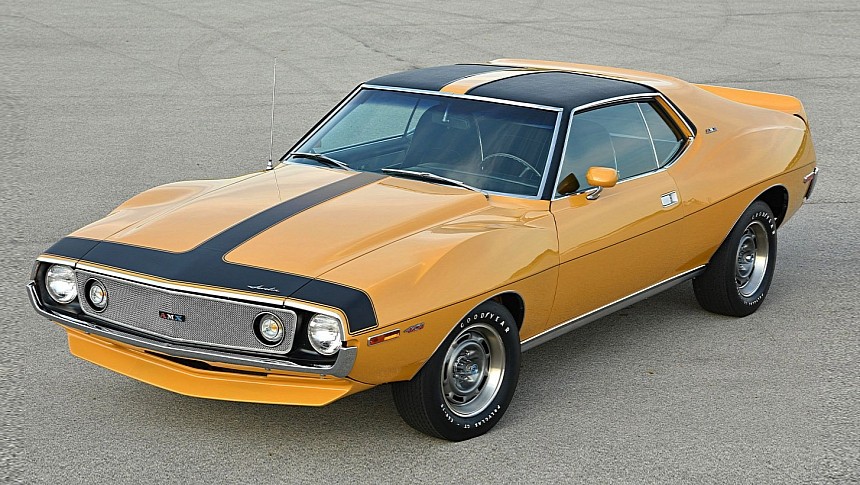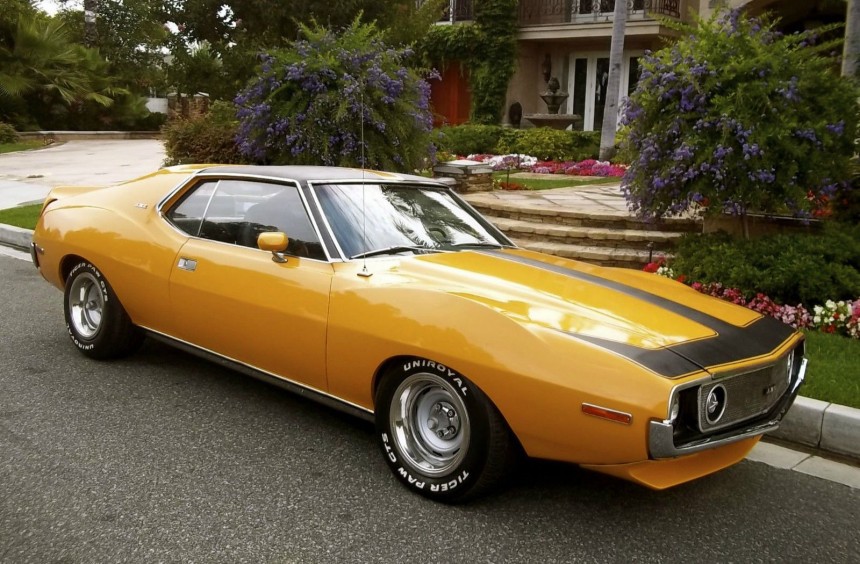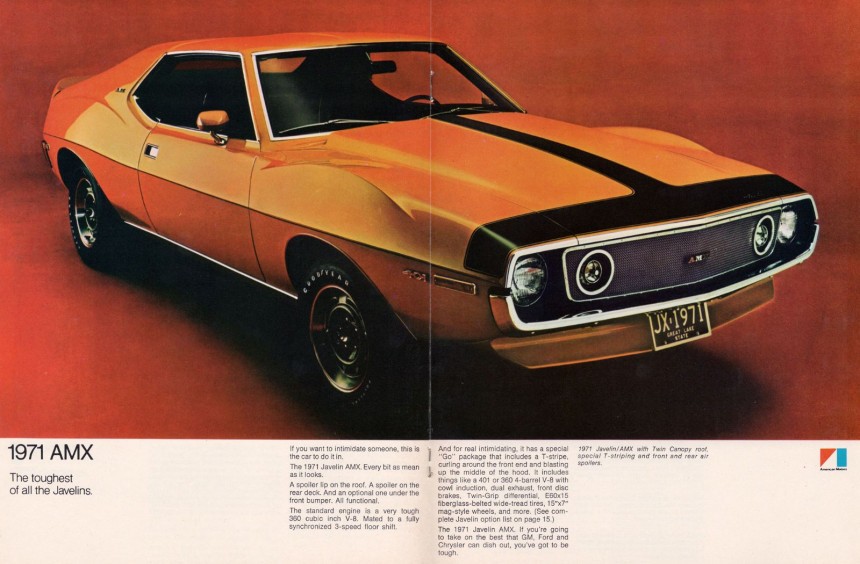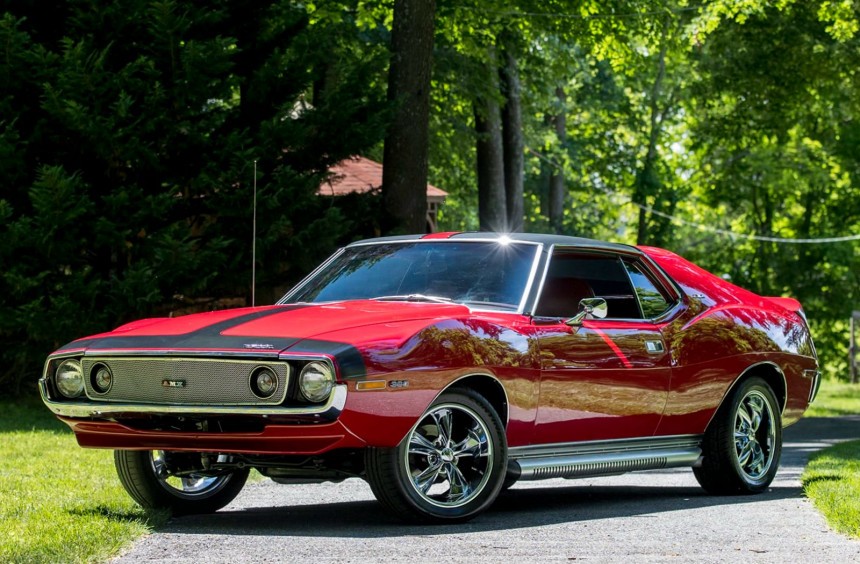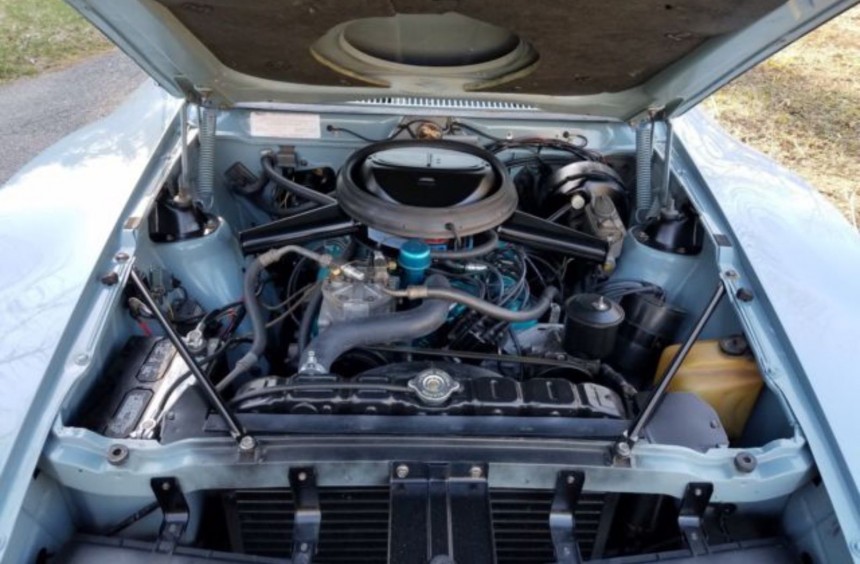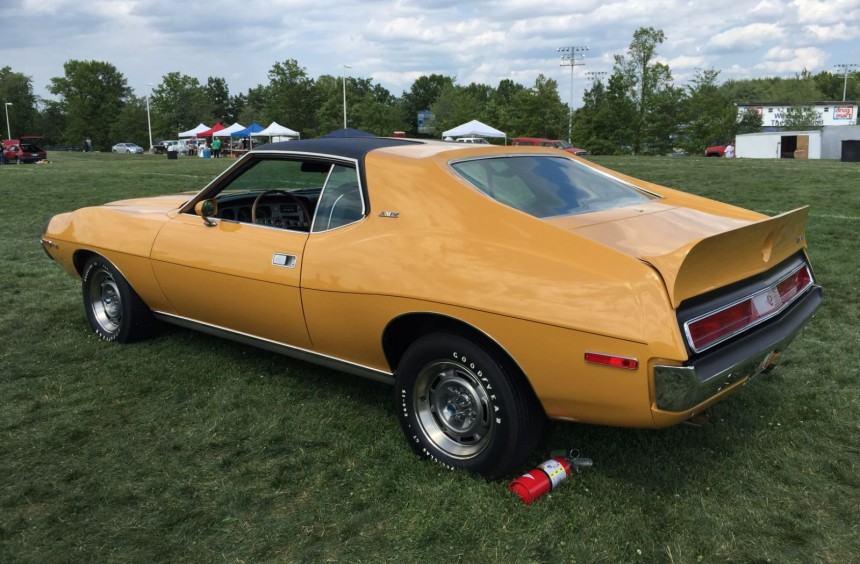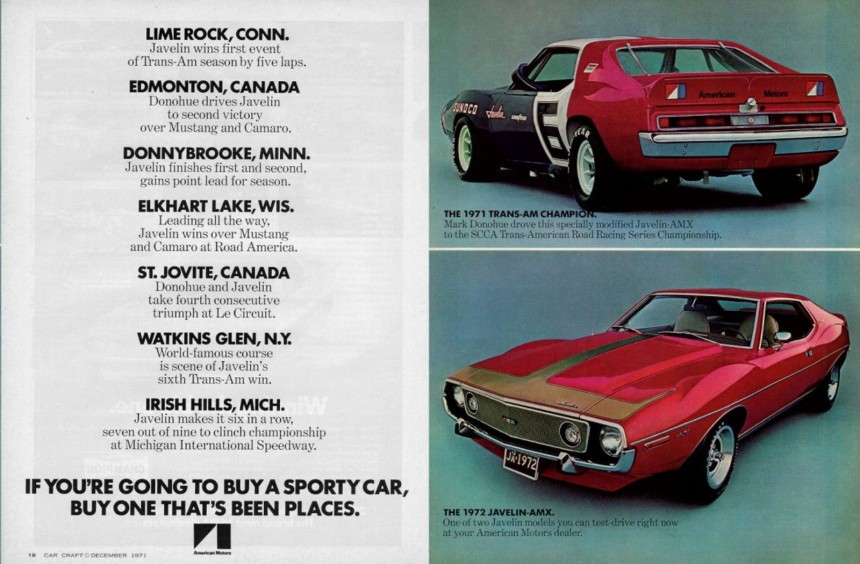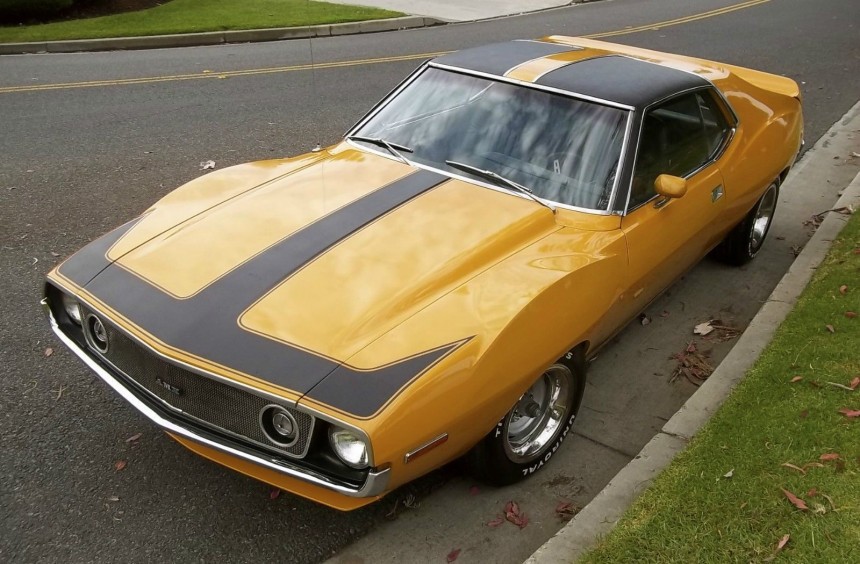If you've dreamed about owning a classic pony car powered by a muscular V8 but don't have the budget for a Mustang, Camaro, or 'Cuda, look no further than the fantastic 1971 Javelin AMX.
By the strict definition, a muscle car is a two-door intermediate coupe powered by a big-block V8. However, most enthusiasts also include pony cars and two-door compact coupes with potent V8s in this category.
Today, some of the most sought-after classic muscle cars (as well as the modern versions) are part of the pony car segment. Ford's iconic Mustang is the best example, followed by its arch rivals: the Chevy Camaro and Dodge Challenger.
Popularity comes at a cost, so values for performance-oriented versions of these popular classics have skyrocketed in recent years.
Thankfully, there's still a reasonably affordable alternative for enthusiasts of pony-turned-muscle cars, and its name is Javelin AMX.
Once based in Kenosha, Wisconsin, the now-defunct American Motors Corporation was the only US carmaker that kept up with Detroit's Big Three during the 1950s, 1960s, and, to some extent, the first half of the 1970s.
It did that by offering well-built models that prioritized safety, reliability, and affordability. However, one of the reasons why AMC didn't rise to the same level of success as its Detroit rivals was its slow reaction to changing market trends.
One example was the pony car segment, which AMC entered in the 1968 model year with the Javelin. By then, the Mustang and Barracuda were almost four years old, whereas GM's Camaro and Firebird debuted a year earlier.
But, despite arriving late to the pony car party, the Javelin was a marketing success for AMC, as it exceeded the company's most optimistic predictions.
In the following model years, the Javelin received more potent engines and was able to compete with the muscular versions of its segment rivals.
Moreover, during the early 1970s, the company, which previously ran advertisements under the slogan "the only race we're concerned with is the human race," won two consecutive Trans-Am manufacturer's titles with the Javelin.
Apart from the Javelin, AMC introduced a mechanically and aesthetically similar two-seat version in 1968.
Dubbed AMX, the model aimed to offer sports car enthusiasts a sensibly cheaper alternative to the Chevrolet Corvette.
While the idea was successful in the first two years, AMX sales dropped significantly in 1970. The company considered releasing a mid-engine, Italian-designed De Tomaso Pantera rival under the AMX nameplate for 1971 but eventually chose to discontinue the model.
Nevertheless, the nameplate wasn't retired but applied to a new, premium, high-performance trim for the Javelin.
In part because AMC wanted to win the Trans-Am title (which it lost by one point in 1970), but also because it wanted to offer potential buyers something new, the Javelin was thoroughly redesigned for the 1971 model year.
Though some components were carried over from the previous model, the second generation featured more aggressive lines and a host of improvements for the Javelin AMX - all aimed at Trans-Am dominance.
These included wider wheel arches (to accommodate bigger race tires without modifications), an integrated decklid spoiler, an additional spoiler at the rear edge of the roof, an optional fiberglass hood with functional cowl induction, and a chin spoiler (also optional) that improved high-speed maneuverability.
Unlike the standard Javelin, the AMX trim was only available with a V8 under the hood.
The stock unit was a 360-ci (5.9-liter) with a two-barrel carb that produced a decent 245 hp. It came with a standard three-speed manual or an optional three-speed automatic -both manufactured by Borg-Warner.
Further up the latter was the optional high-compression, four-barrel 360 that brought 40 additional ponies, enabling buyers to get the optional dual exhaust and the BorgWarner T-10 four-speed, Hurst-shifted manual.
The top option was a 330-hp, 401-ci (6.6-liter) V8 that could be had with either a Torque-Command three-speed automatic or the four-speed T-10.
This option marked the first time an engine larger than 400 ci (6.5 liters) was offered on the Javelin. Again, AMC was a couple of years too late to adjust to market trends, but, as they say, better late than never.
As standard, the Javelin AMX benefited from premium features such as front disc brakes and a front anti-roll bar.
However, buyers who wanted more than the standard features and either one of the optional four-barrel 360 or 401 V8 could get the Go Package.
It added stiffer springs, a beefier anti-roll bar, a heavy-duty cooling system, power-assisted brakes, a Twin-Grip limited-slip differential, the functional cowl-induction hood adorned with a T-stripe decal, a blacked-out rear panel, and Rally-Pac instruments, including a Tick-Tach clock-in-tachometer and a 140 mph (225 kph).
When equipped with the 401, the 3,244-pound (1,471 kg) Javelin AMX could run the quarter-mile in the mid-14s at 93 mph (150 kph).
While it wasn't the fastest factory-built muscle car available, the AMX wasn't far behind its more expensive rivals.
For the 1971 Sports Car Club of America (SCCA) Trans-Am season, AMC delivered new AMX Javelins to its factory-backed team, including Penske Racing.
Driven by Mark Donohue, the Penske AMX won eight out of the ten races it appeared in that season, bringing AMC its first Trans-Am manufacturer's title.
The company defended its title in 1972 when George Follmer (who substituted the injured Donohue) drove the AMX to victory in four out of seven races.
In 1971, the manufacturer sold only 2,054 AMX units, of which 745 were equipped with the powerful 401 engine.
With minor improvements, the Javelin AMX survived until the end of the 1974 model year, but from 1972 onwards, performance dropped significantly.
Today, the 1971 AMXs are some of the most sought-after Javelins ever produced. But when I say "saught-after," I refer to die-hard AMC fans because the larger pool of classic muscle car enthusiasts either forget about or dismiss the model just because it didn't come from one of the Detroit carmakers.
Therefore, the 1971 Javelin AMX is currently one of the cheapest muscle cars from the golden age. The average value for a surviving unit in good condition now stands at $25,000.
You can find a well-kept, highly original Go Package, 360 four-barrel car for that kind of money. But if you want something even cheaper, a standard two-barrel 360 is the obvious choice.
On the other hand, if you want the rarer, more powerful 401 version, like the one featured in the video below by Lou Costabile, be prepared to pay over $40,000 for one and arm yourself with patience because it isn't easy to find.
Though not as glamorous as rivaling models from the same era, the 1971 AMC Javelin AMX is a terrific classic muscle car that deserves more respect and serious consideration by enthusiasts with tight budgets.
Today, some of the most sought-after classic muscle cars (as well as the modern versions) are part of the pony car segment. Ford's iconic Mustang is the best example, followed by its arch rivals: the Chevy Camaro and Dodge Challenger.
Popularity comes at a cost, so values for performance-oriented versions of these popular classics have skyrocketed in recent years.
Thankfully, there's still a reasonably affordable alternative for enthusiasts of pony-turned-muscle cars, and its name is Javelin AMX.
A brief history of the AMC Javelin
It did that by offering well-built models that prioritized safety, reliability, and affordability. However, one of the reasons why AMC didn't rise to the same level of success as its Detroit rivals was its slow reaction to changing market trends.
One example was the pony car segment, which AMC entered in the 1968 model year with the Javelin. By then, the Mustang and Barracuda were almost four years old, whereas GM's Camaro and Firebird debuted a year earlier.
But, despite arriving late to the pony car party, the Javelin was a marketing success for AMC, as it exceeded the company's most optimistic predictions.
In the following model years, the Javelin received more potent engines and was able to compete with the muscular versions of its segment rivals.
Moreover, during the early 1970s, the company, which previously ran advertisements under the slogan "the only race we're concerned with is the human race," won two consecutive Trans-Am manufacturer's titles with the Javelin.
From affordable Corvette alternative to high-performance Javelin trim
Dubbed AMX, the model aimed to offer sports car enthusiasts a sensibly cheaper alternative to the Chevrolet Corvette.
While the idea was successful in the first two years, AMX sales dropped significantly in 1970. The company considered releasing a mid-engine, Italian-designed De Tomaso Pantera rival under the AMX nameplate for 1971 but eventually chose to discontinue the model.
Nevertheless, the nameplate wasn't retired but applied to a new, premium, high-performance trim for the Javelin.
A more aggressive look with race-ready features
Though some components were carried over from the previous model, the second generation featured more aggressive lines and a host of improvements for the Javelin AMX - all aimed at Trans-Am dominance.
These included wider wheel arches (to accommodate bigger race tires without modifications), an integrated decklid spoiler, an additional spoiler at the rear edge of the roof, an optional fiberglass hood with functional cowl induction, and a chin spoiler (also optional) that improved high-speed maneuverability.
Three engine setups to choose from
The stock unit was a 360-ci (5.9-liter) with a two-barrel carb that produced a decent 245 hp. It came with a standard three-speed manual or an optional three-speed automatic -both manufactured by Borg-Warner.
Further up the latter was the optional high-compression, four-barrel 360 that brought 40 additional ponies, enabling buyers to get the optional dual exhaust and the BorgWarner T-10 four-speed, Hurst-shifted manual.
The top option was a 330-hp, 401-ci (6.6-liter) V8 that could be had with either a Torque-Command three-speed automatic or the four-speed T-10.
This option marked the first time an engine larger than 400 ci (6.5 liters) was offered on the Javelin. Again, AMC was a couple of years too late to adjust to market trends, but, as they say, better late than never.
The Go Package
However, buyers who wanted more than the standard features and either one of the optional four-barrel 360 or 401 V8 could get the Go Package.
It added stiffer springs, a beefier anti-roll bar, a heavy-duty cooling system, power-assisted brakes, a Twin-Grip limited-slip differential, the functional cowl-induction hood adorned with a T-stripe decal, a blacked-out rear panel, and Rally-Pac instruments, including a Tick-Tach clock-in-tachometer and a 140 mph (225 kph).
A solid performer and a Trans-Am winner
While it wasn't the fastest factory-built muscle car available, the AMX wasn't far behind its more expensive rivals.
For the 1971 Sports Car Club of America (SCCA) Trans-Am season, AMC delivered new AMX Javelins to its factory-backed team, including Penske Racing.
Driven by Mark Donohue, the Penske AMX won eight out of the ten races it appeared in that season, bringing AMC its first Trans-Am manufacturer's title.
The company defended its title in 1972 when George Follmer (who substituted the injured Donohue) drove the AMX to victory in four out of seven races.
The 1971 AMC Javelin AMX today
With minor improvements, the Javelin AMX survived until the end of the 1974 model year, but from 1972 onwards, performance dropped significantly.
Today, the 1971 AMXs are some of the most sought-after Javelins ever produced. But when I say "saught-after," I refer to die-hard AMC fans because the larger pool of classic muscle car enthusiasts either forget about or dismiss the model just because it didn't come from one of the Detroit carmakers.
Therefore, the 1971 Javelin AMX is currently one of the cheapest muscle cars from the golden age. The average value for a surviving unit in good condition now stands at $25,000.
You can find a well-kept, highly original Go Package, 360 four-barrel car for that kind of money. But if you want something even cheaper, a standard two-barrel 360 is the obvious choice.
On the other hand, if you want the rarer, more powerful 401 version, like the one featured in the video below by Lou Costabile, be prepared to pay over $40,000 for one and arm yourself with patience because it isn't easy to find.
Though not as glamorous as rivaling models from the same era, the 1971 AMC Javelin AMX is a terrific classic muscle car that deserves more respect and serious consideration by enthusiasts with tight budgets.
